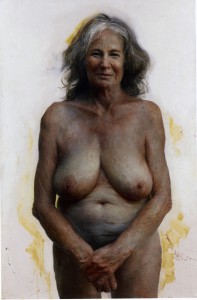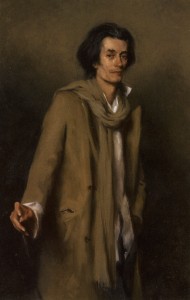 Almost part of The Season now, the only surprise these days about the annual BP Portrait Award is that the Queen doesn’t cut the ribbon and hand out the rosettes. As ever, this year is as popular with the public as any art exhibition, with large numbers jostling and genuinely engaging with the work eagerly discussing merits and demerits of more conspicuous pieces.
Almost part of The Season now, the only surprise these days about the annual BP Portrait Award is that the Queen doesn’t cut the ribbon and hand out the rosettes. As ever, this year is as popular with the public as any art exhibition, with large numbers jostling and genuinely engaging with the work eagerly discussing merits and demerits of more conspicuous pieces.
As usual the winning picture, Auntie by 26-year-old American Aleah Chapin, is not the most refined effort though it deserves commendation – if only because the sitter has comfortably the noisiest breasts in the show. One subject of the picture is perhaps what the ageing process does to flesh and muscle, although the painter has presented it in an original and not necessarily unflattering way, suggesting that while the run in to death might be sad it is not always unsightly.
Somewhat off sharp focus and pinned specimen-like to an unfinished background to which the figure’s outline is here and there uncomfortably cut, the sitter confronts us very slightly as if from the past, as though the painter has approached her subject wistfully. Auntie seems not to be fully in the present and invites thoughts of how in old age personalities, histories, gradually dissolve. It is a nicely judged picture, and there’s love in it.
 Isabella Watling presents The Importance of Being Glenn. Less conspicuous and subtler than the winner, it is duller but arguably more artfully painted. Watling is the more impressive painter for having been classically trained at the Charles H Cecil Academy in Florence, where she is still a student. Indeed, the winner of the Young Artist’s prize, Jamie Routley, is also a graduate of this school, as is another potentially successful young artist Tim Gatenby, for a portrait of his grandmother. Any of these three might win the prize in the future. The work of the Cecil Academy’s graduates – the impressive Frances Bell is another – stands out in the context of those paintings which use overbearing narratives, a cornucopia of details, sloppy painting and overblown heads copied from photographs or projections. Look out for this quartet, their pictures sit back and wait for the discerning passer-by.
Isabella Watling presents The Importance of Being Glenn. Less conspicuous and subtler than the winner, it is duller but arguably more artfully painted. Watling is the more impressive painter for having been classically trained at the Charles H Cecil Academy in Florence, where she is still a student. Indeed, the winner of the Young Artist’s prize, Jamie Routley, is also a graduate of this school, as is another potentially successful young artist Tim Gatenby, for a portrait of his grandmother. Any of these three might win the prize in the future. The work of the Cecil Academy’s graduates – the impressive Frances Bell is another – stands out in the context of those paintings which use overbearing narratives, a cornucopia of details, sloppy painting and overblown heads copied from photographs or projections. Look out for this quartet, their pictures sit back and wait for the discerning passer-by.
There were also convincing efforts by Antonio Barahona, Roni Taharlev, Benjamin Sullivan and Ben Ashton, all of whom rely on expression through observation rather than deliberate sloppiness and vulgar gimmicks.
An intriguing oddity is a stylised scene in a Japanese sushi restaurant, painted by Carl Randall (who won the Travel Award), which is not strictly speaking a portrait so much as a novel documentary. Seen almost from above, assorted diners are trapped in their own worlds and silhouettes while troughing busily with chopsticks.
One welcome addition this year is the judges’ statements – albeit too brief – as to why they selected the prizewinners. This should be done as a matter of routine in all competitions of this sort. If organisers are to continue with such elaboration it must be better done next year. Third-prize winner, Alan Coulson, is praised as follows: “The modulation of tone and attention to detail successfully brought the style and subject together.” ‘Modulation of tone’ is a cliché, doubly unhelpful in this instance because Coulson’s isn’t a tonal painting. Perhaps what is really meant here is the even gradation from light to dark, which is indeed carefully modulated in the sitter’s white T-shirt, but nowhere else. Looking at the list of judges, it occurs that there isn’t a painter present, an accomplished sculptor yes, but not a painter. A painter as a judge in a painting prize may be too obvious a step for the State Art establishment but it would have saved them making such a ham-fisted mistake.
The second prizewinner, meanwhile, was chosen because it was “intensely atmospheric, thoughtful and focused” – “murky” seems more appropriate. If you’re desperately trying to find something to say this is the kind of adaptable phrase applicable to most paintings. When justifying a choice, it must be done more convincingly than this by avoiding such flannel, so that we viewers enjoy the benefit of the judge’s greater expertise – then we are able to say “Oh yes, well spotted, so it is”, and not respond with a bewildered “Eh?”. As it stands with this year’s explanatory efforts one can have no confidence that the judges have a clue why those selected for honour are outstanding in the company.
For all its usual failings – not least the fact that a good twenty pictures don’t deserve to be hung at all – this is a moderately diverting exhibition in which to dodge the showers.
The BP Portrait Award is at the National Portrait Gallery until September 23rd; the Scottish National Portrait Gallery, Edinburgh from November 3rd to January 27th; and the Royal Albert Memorial Museum in Exeter from February 9th to May 19th, 2013.
David Lee
The Jackdaw, June 2012
